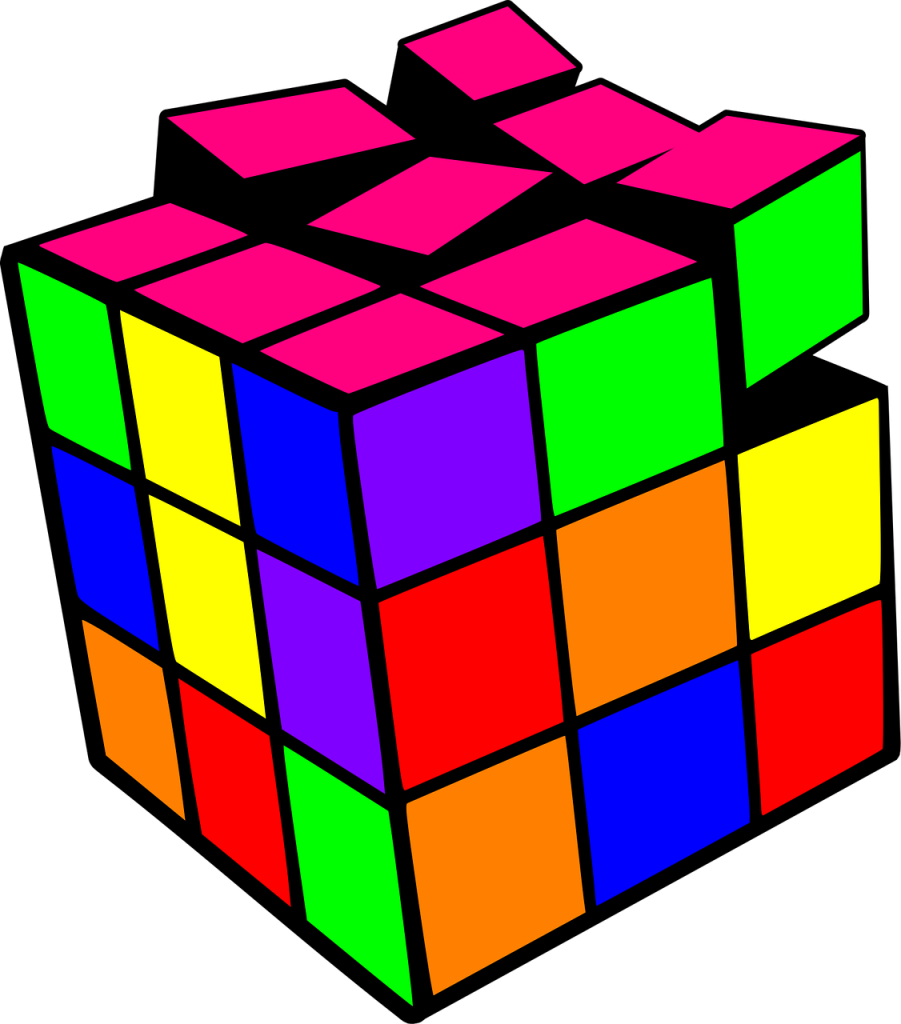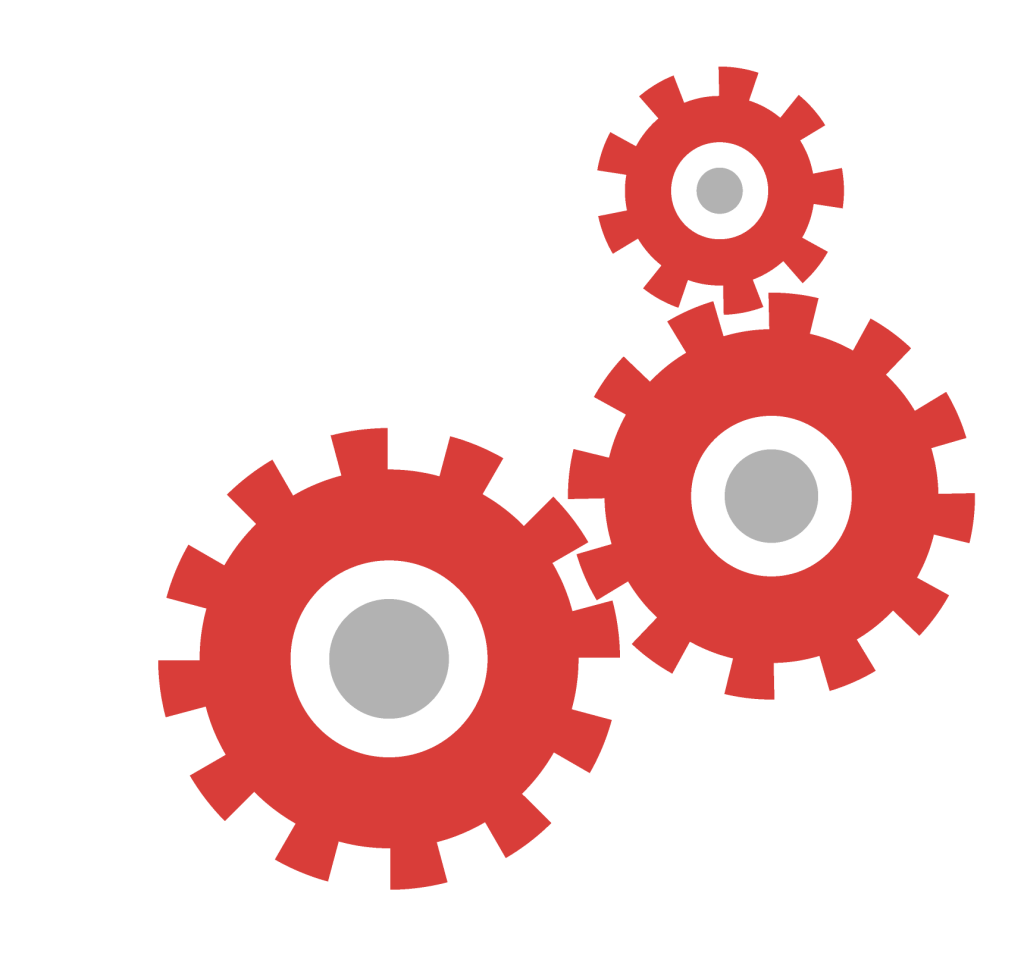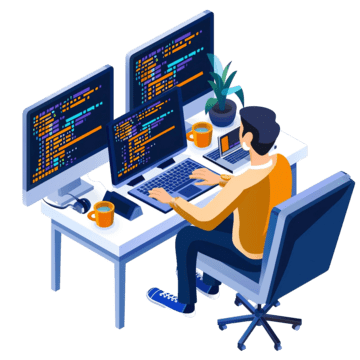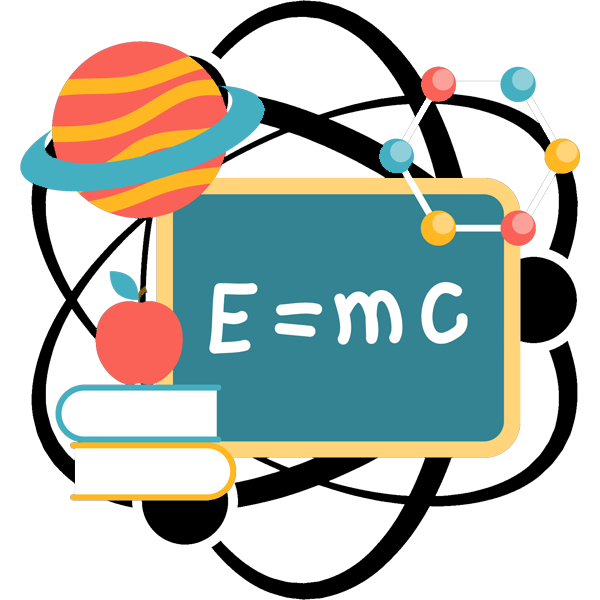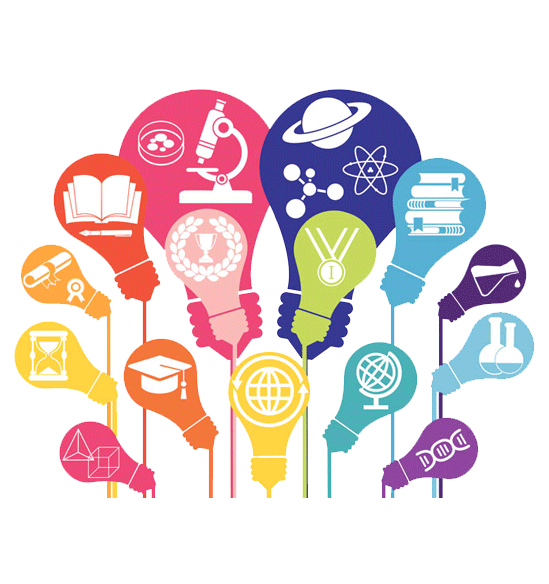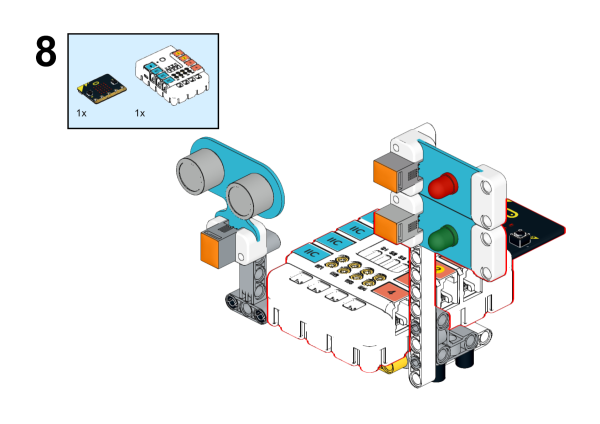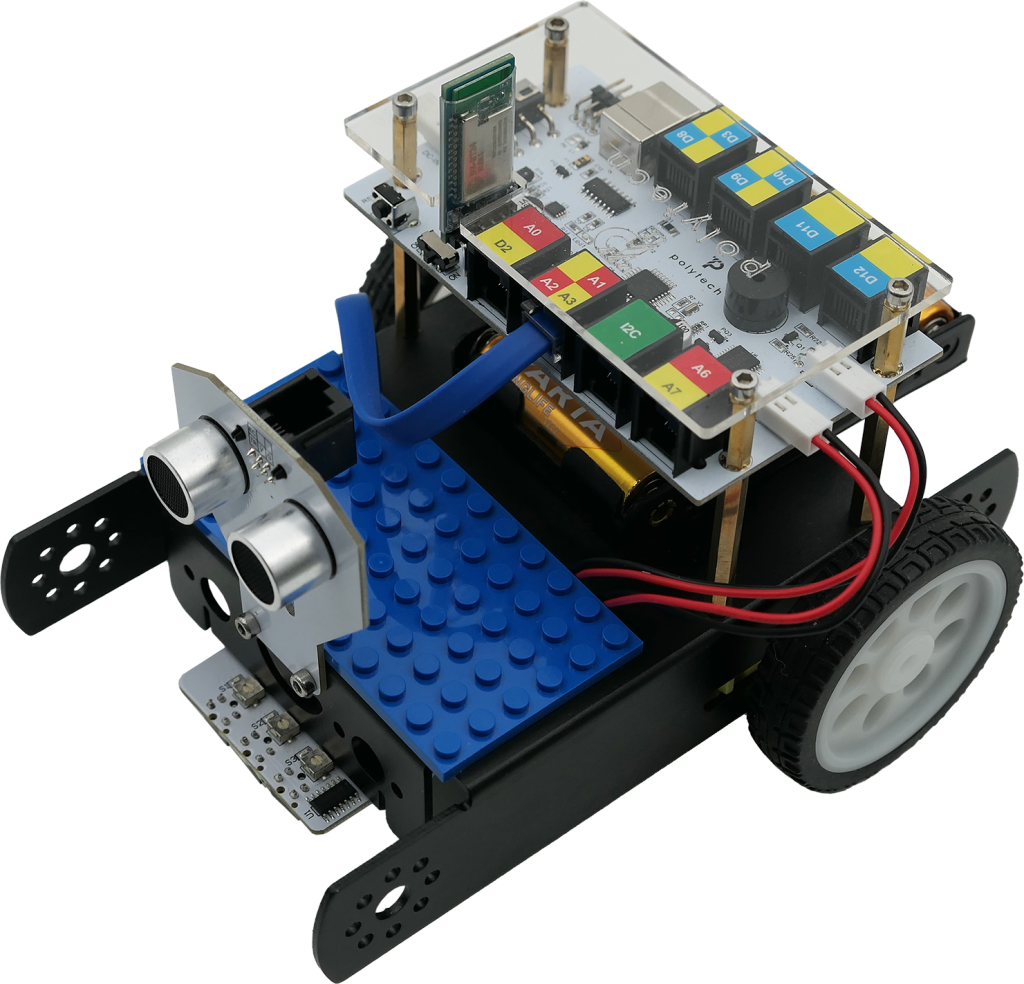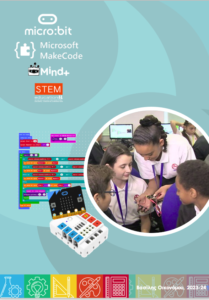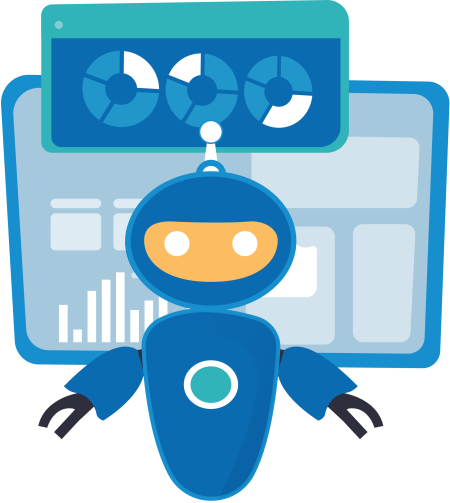Erkynas, Review of Educational and Scientific Issues, Issue 23, 84-108, 2021
Educational Robotics for the Primary School of WRO Hellas Yannis Somalakidis1, Tasos Ladias2,
ioannisomos@gmail.com, ladiastas@gmail.com 1WRO Hellas, 2STEM Education
Summary. This educational article develops the reflections, the vision, the goals and the methods for the development of STEM education in Greece through the Panhellenic Competition Educational Robotics for Primary School of WRO Hellas. At the beginning, the identity of the Competition and its philosophy are given through the decision to address primary school students, to have characteristics of sport and not of championship, to have an “open category” character and to be based on the dual nature of robotics for the choices of hardware and software to be used. The innovations adopted are then described, such as the simulation of automation, the code vision representation of the program, the taking of physical size measurements and image recognition on the fringes of artificial intelligence. The next stage develops the topics of the competition, the teams’ deliverables, the presentation of the project by the students and the evaluation process. Finally, the article concludes with a reference to the synergies of the competition, the dissemination of its results to society, a brief review and suggestions for its future.
Key words: Educational robotics competition, automation, WRO Hellas, Introduction
Reflections
A great country can have every field of science and technology developed, and this totality is expressed through STEM education. For our country the questions are: How can we benefit from STEM education? How can we – without uncritically copying what comes from Hesperia – adapt it to our own circumstances and apply it effectively to meet our needs? How does STEM touch production in Greece during the crisis? What does Greece produce today and what can it produce in a highly competitive and globalized environment? Greece is not a big country and it is difficult – in the context of globalization – to have an all-round development. What to do? What does it have? What is it that will make its mark on the world production map? When that is found, that is what its education should be directed towards.
The easy answer is WHAT needs to be done. But there is difficulty in HOW. The Greeks as children of Odysseus are resourceful. In their history they have often shown that they can manage chaos. Historically as a country we have survived many worse crises. Let us first choose to operate where we have an advantage. Where we are strong? In maritime Greece tourism seems to be a solution. On the mainland, the diversity of the climate and the dispersion of the soils are suitable for small-scale, quality-oriented, specialised, specialised, quality-oriented agricultural and livestock production, turning the disadvantage of small-scale production into an advantage with branded products. However, there is a problem with the urban population, especially that of the Attica basin, with its four million inhabitants. A population that in the crisis (especially young people) has been hit by unemployment, the main characteristic of which is that a large proportion of them have higher education, which gives them the flexibility to turn to entrepreneurship. The size of this population provides a comparative advantage (equivalent to an economy of scale), innovation in a city of 4,000,000 inhabitants is not only 10 times greater than in a city of 400,000 inhabitants, but according to Kleiber’s power law distribution it is 17 times greater. How do we exploit this advantage? How do we highlight these potential innovation opportunities? What sector of industry does not need major investments in plant, raw materials, energy and equipment? Software! (Ladias, 2014).
And what kind of software should we produce? What we have an immediate need to consume. Perhaps one solution is the threat from the East and the immediate but constant need for defence equipment (“War is the father of all”). Then by converting this defence know-how into political directions we can make our mark in the globalised business environment by aiming to become software exporters. Such examples of outward-looking high-tech exporters are countries (without natural wealth) such as devastated post-war Japan (Morita, 1988) and encircled modern Israel.
In this project we need businesses. Large or small businesses? Because “Small (within the big) is beautiful” (Schumacher, 1980) we need large networks of small businesses and as a coordinator a national champion company (example Nokia in Finland, with all the risks involved). Thus the Attica basin can develop into a small Silicon Valley in Southeast Europe. In this way the software industry can become the engine of the whole Greek post-industry.
The vision
The software industry does not need large industrial facilities and heavy equipment but heads, brains that solve problems, discover and invent, create ideas, transform them into innovation and apply them to generate profit. Our country has such a human potential that can be increased by a successful brain gain. But this investment must also ensure that the necessary resources (brains) are available in the long term. The answer lies in the STEM education of the new generation. A STEM education adapted to the Greek reality and specialized to Greek needs and specificities. The implementation of STEM education had to be immediate and therefore resorting to state bureaucracy with its huge inertia simply ensures certain failure. The solution to this problem was to create a parallel structure that would work alongside the formal school, creating the right conditions for the consolidation of STEM education.
In the ecosystem developed in the context of this competition, the conditions of the Greek post-industrial model are reproduced on a micro-scale. In the competition, robotic hardware is purchased and as a domestic value-added, applications are developed that synthesize the equipment into intelligent integrated systems that solve problems. Example: Educational robotics competitions where imported hardware is purchased and used by combining it in an original way and programming it (cognitive added value) so that it solves real problems and (paradoxical as it may sound) that at the student level, high-tech products made in Greece are eventually produced.
Robotics, STEM and educational robotics competitions
The Robotics
Robotics is an offshoot of the evolution of automation, which is concerned with the study, design and operation of robots. A programmable robot is an entity capable, through programming, of perceiving its changing environment and fulfilling specific actions and tasks in advance and is therefore considered to be endowed with autonomy.
The Educational Robotics
Educational robotics is an activity involving a computational environment consisting of one or more robots (either autonomously or accompanied by a computer). It is considered as a pedagogical tool capable of leading to the development of high-level cognitive skills based on the learning theory of constructivism (Piaget, 1974) and the principles of constructivism (Papert , 1991). In these contexts, the student with the physicality of robots transcends the narrow confines of the screen and engages with the real world by evolving mathematical thinking from problem solving under ideal conditions to engineering thinking that has to deal with the intractable physical reality.
Educational robotics in practice can be used in two ways, either as an object of study or as a learning tool. The now available – not exact – robotic architectures enable educational robotics to be used as a learning tool in primary education.
Educational Robotics in the context of STEM
Educational robotics using robots as learning tools is considered an excellent tool for introducing students to STEM education. According to Georgopoulou (2017), by designing appropriate activities, educational robotics can meet all the objectives (interdisciplinarity, problem solving, creativity and logical and indefinite reasoning) that define the spirit of STEM education.
Promotion of educational robotics through the Robotics Competitions
Educational robotics competitions are an effective way to focus students’ attention on robotics. Students in educational robotics competitions – as in STEM education – are assessed not on theoretical knowledge but on the extent to which they have assimilated it and can apply it to solve real-world problems. In recent years in Greece, events that promote and promote robotics have become institutions, such as national and international robotics competitions, up to national festivals and local exhibitions of robotics projects (Katsavou, 2017). The oldest competition and with a dominant position among them is that of WRO Hellas.
The non-profit Educational Robotics & Robotics Education Organization Science WRO Hellas -as a member of the World Robot Olympiad Association- is the official organizer of the WROTM Educational Robotics Olympiad for Greece and the wider region of Southeast Europe.

Image from 1. Project mock-ups from the 2021 Final Competition The identity of the Competition
WRO Hellas organizes two distinct competitions: (a) the WRO Educational Robotics Olympiad and (b) the Panhellenic Educational Robotics Competition. The WRO Educational Robotics Competition is organized in the following categories, for students of Kindergarten, Primary School, Secondary School and High School. The elementary school category includes “Football 2×2” and “Open Category“. The ‘Open Category’ is divided into two tiers: (a) for the First Grades (grades A to C) and (b) for the Final Grades (grades Cto 6) .
Hereinafter referred to as Competition will be referred to the Open Category of the last classes of the Primary School, of the Panhellenic Educational Robotics Competition, of WRO Hellas.
This competition is an annual educational activity, with a different theme every year, addressed to groups of 3-6 children, accompanied and guided by an adult coach (teacher, parent…), it is initially held in all regions of the country and ends with the final in Athens, it is organized by WRO Hellas with STEM Education as scientific advisor and COSMOTE as strategic partner, it is under the auspices of the Ministry of Education or the Presidency of the Republic, it is announced in autumn and ends in early spring, as far as possible, it ensures that sponsorships are secured for the supply of robot equipment for public schools, provides free and free registration/participation for all teams and finally offers free intensive seminars related to the hardware and software of the automation systems for the preparation of coaches.
Participation in the Contest from the first year in 2015 until before the pandemic was impressive, with live participation per year being respectively 508, 350, 371 and

Image from 2. Panoramic view of the 2018 Competition in Galati.
386 teams, which means that an average of about 1600 children participated each year from all over Greece. According to a study, this number represents about 1/3 of the student population that participates annually in all the individual competitions of WRO Hellas.
Due to the large number of entries, the Competition is conducted in two phases:
(a) The Regional Competitions are held at the headquarters of each Region at
end of Winter.
(b) the Final Competition which is held in Attica in person (pre-pandemic) and involves the approximately 80 to 90 teams that qualify from the Regional Competitions.
The first three teams claim the medals (gold, silver and bronze), while special thematic prizes are awarded to a limited number of teams whose work excels in individual criteria of the competition, e.g. the best comic vision, a truly original idea, an impressive model, a theatrical presentation, a business proposal, etc.
The philosophy of Competition
The philosophy of the Tender is for the students involved to acquire knowledge through analysis and synthesis while trying to solve problems, to freely develop their imagination in the construction of the model, to improve their communication skills when presenting the project, to become familiar with teamwork, to enjoy the joy of creation, to keep in mind the commercial exploitation of their product, to gain confidence in themselves as producers of potentially innovative products and to gain experience by working creatively in a variety of fields such as structural design, the electronic part of automation and programming simulation with animation. In order for the above characteristics to emerge, the following decisive choices had to be made with regard to the character of the competition.

Image from 3. On the left, the team that won the gold medal in the 2019 Mars Colonisation Competition and on the right, the team that won the special thematic prize for the 2021 Code Vision.
The choice of the Competition to be addressed to primary school pupils
The Competition was designed from the beginning in 2014 as a nursery of experienced students with skills in automation and educational robotics and to create an active core of teachers-coaches trained in STEM education.Its aim was and is to create a large pool of students and teachers on the one hand to cultivate STEM education within the educational community and on the other hand to draw from the pool the most competent ones who will participate with claims for distinctions, representing the best in the field.
Sport or championship of the teams in the Competition
As the experience of the Competitions has shown, as a rule, winning distinctions is the result of long-term participation of students and coaches in the Competitions. However, “championship” is not the goal. The gain for each child from participating in the Competition is, on the one hand, the joy of creativity experienced during his/her involvement in the project and the positive memory of this experience that will accompany him/her throughout his/her life after school and, on the other hand, the skills he/she will acquire such as analytical and compositional skills, improved communication skills, familiarity with teamwork, the development of creative thinking and the confidence he/she will feel as a producer of potentially innovative products.
In this context, it is proposed that the teams be composed of students of all ages (participating in the competition) so that the know-how acquired by the team’s participation in a Competition is maintained, diffused and deepened through the team’s participation in subsequent Competitions, thus ensuring the continuity of the ambitious effort of the children, the team and the school.
The selection of the “Open Category” character in the Competition
A key decision regarding the nature of the Competition was the choice of whether it would be “open” or “regular”.
In a “Normal Class” race, the contestants’ robot has a challenge to face. The students must design, assemble and

Figure 4. The joy of creation and the celebrations of victory
program their robots to be capable of tackling specific challenges in a given field within a given timeframe and by following given rules. For example, the robot has to be as fast as possible – to follow a route on a predefined track and complete various tasks. The achievement of the challenges and the completion time determine the ranking of the teams.
On the contrary, an “Open Category” competition is a competition based on the development of projects (project-based) related to a theme. Contestants are asked to invent, design and implement innovative solutions using intelligent robots or automation.
Thus in the “Normal Category” the mix of convergent and divergent thinking shifts towards computational thinking, while in the “Open Category” there are also strong features of creative thinking and innovation. We believe that the choice of the Competition to have the character of the “Open Category”, is more suited to the extroverted temperament of the Greek, which gives an advantage to Greek teams in international competitions, as shown by the results of the last Olympiad (2021) where 3/4 of our distinctions were in the Open Category.
The dual nature of educational robotics
Since educational robotics has a dual nature based on the construction of mechanical systems on the one hand and their control by computer programming on the other, the knowledge background of the participants in the competition – which can be both a prerequisite and a result of their participation – is the acquisition of solid knowledge in these two areas. It should be noted in passing that the emphasis on construction is given in the Open Category competition for the first grades of primary school, which is in synergy with the Competition.
The mechanical construction created by the students uses a set of building materials and has sensors to detect events and usually a motion mechanism to set the whole or part of the construction in motion. In addition, the

Image from 5. On the left a “normal class” track and on the right a model with “open class” automations.
operation of the structure is based on software that controls and determines the behaviour of the structure according to the state of its environment. Thus in the process of developing the mechanical construction and its control program, there is a two-way relationship. The design of a structure (hardware) and its mode of operation (software) requires the interplay of these processes. It seems particularly effective that on the one hand, students in the role of programmers have an understanding of the development model of the structure and on the other hand, students in the role of constructors have built the mental model of the operation of the structure. This dialectical relationship between the development of the construction and the programming of its operation will lead to constructions (at least at the initial stage) that can be programmed effectively, bearing in mind that ‘the programming of robotic constructions has a specificity compared to programming in other conditions or situations. It is identified with the performance of behaviour in an artificial construction” (Tsovolas & Komis, 2008).
The simulation of an automation
In the context of bridging the dual nature of educational robotics projects is the requirement in the Competition to implement a simulation using at least one automation. Specifically, during the operation of the automation, the input data from the sensor should also be used by the simulation program so that in parallel with the automation activity

Image from 6. Educational robotics has a dual nature based on the construction of mechanical systems on the one hand and their control by computer programming on the other hand.
the simulated – virtual actuators are activated simultaneously and their action is displayed in the form of an animation in the software environment.
The adoption of the software Scratch on Competition
From the moment of its conception, the Competition has been constantly trying to introduce innovations. Since the beginning of the Contest (2015), the first innovation is the use of the free Scratch software for the control of automation, instead of the proposed software of the manufacturers of the hardware to be used. This allowed, in addition to the control of the automations, the development and production of a computer screen simulation (in the Scratch scene) using animation, on at least one of the automations. As a result, the specific weight of programming in the students’ projects was significantly increased, which was the main rationale behind the creation of the Competition. This emphasis on shifting the focus towards programming is based on the view that a privileged field in the Greek specificity is the development of a Greek software industry.
Scratch, created by the Lifelong Kindergarten Group at MIT, is a media-rich system for beginning programmers. It is a visual tile programming language (a metaphor from Lego bricks) that allows users to program via graphical elements instead of text, and is embedded in a dedicated programming environment. This overcomes the limitation of the syntax difficulties present in traditional code-text based programming languages.
In Scratch, programming is event-driven and implemented by programming scripts that combine tile commands that apply to each other to determine the behavior of roles. Developing programming in Scratch allows students to create and develop programs related to animation, narratives , and games, which can expand their understanding of computational concepts as well as computational practices (Resnick et al., 2009).
Scratch as a programming language is the means of communication between intelligent entities, the human and the computing machine. The communication takes place at the level of the lowest mental entity. The task of the higher entity is to understand the “culture” of the other entity, to analyze its thinking and simplify it. According to Papert, “to lead the computer to do something, you have to describe the relevant process with enough precision for the machine to perform it… by teaching the computer how to think, children set out on an exploration of their own way of thinking , and thinking about thinking makes the child a scientist.”
Scratch supports a variety of programming styles such as serial programming (with elements of structured programming), parallel programming, event-driven programming, and object-based programming, while using clones, it has elements of object-oriented programming. In Scratch, the ability to program visually with tiles, combined with the variety of programming styles and in the light of ’emergent literacy’, makes it an ideal tool for novice programmers, offering them an accessible starting point for learning.
From the design of the Contest , the basic prerequisite for the choice of hardware was the predetermined decision to choose Scratch. This placed constraints on the choice of hardware to be used. This hardware had to be compatible with Scratch. Compatibility with Scratch had to be not only limited to the management of the hardware but at the same time it had to be able to produce the necessary simulation of the one automation mentioned above.
Additional criteria for selecting hardware were:
(a) to be as easy to use as possible and with the highest added educational and pedagogical value,
(b) to have an affordable acquisition cost ,
(c) to have satisfactory reliability of the company producing it with the longest possible production line life and technical support, and
(d) be flexible and with as much connectivity as possible with sensors and actuators from other manufacturers.
The combination of the above condition with the additional criteria led to the selection of the LEGO WeDo robotic kit. The participation of more than 350 teams in the first Competition is a substantial indication that the choice of WeDo was a feasible solution at least from a financial point of view considering that in 2015 we are at the nadir of the Greek debt crisis.

Image from 7. Example of using a flag in parallel programming in Scratch. The criteria for selecting the hardware for the Competition
Gradual evolution of hardware and software options in the Tender
The constant search for complementary and/or alternative options for hardware and the opportunity (due to the pandemic) of reflection that was given to us, led to the adoption of an additional – low-cost – microcontroller of the BBC micro:bit in the 2022 Competition. The purpose of using the micro:bit is to familiarise primary school pupils with the experimental collection of data from a sequence of physical quantity measurements (something missing from compulsory education) and data processing. Following the staggered inclusion of innovations in the competitive process, the use of automation with the micro:bit will be mandatory but not graded for 2022.
In addition, in the 2022 Competition , with the intention of more fully exploiting the capabilities of the micro:bit microcontroller, the use of the Scratch-like Mind+ programming environment of the Chinese company DFRobot was introduced -under test and as an alternative to Scratch-. With the adoption of Mind+, compatibility with additional robotics platforms is achieved.
Based on the aforementioned options, the hardware required for a team to have for the project it will present in the Competition is:
[WeDo] AND [micro:bit] AND [Web Camera] AND [up to two laptops].
Please note that the use of other materials is only allowed for the model and the props of the project.

Image from 8. The hardware platforms that are compatible with the Scratch-3 and the Mind+ The hardware and software of the Contest 2022
Based on these options, the software that a team is required to have for the project it will present in the Competition is:
[Scratch-2] OR/OR [Scratch-3] OR/OR [Mind+].
Note that all of the above is free software and that Scratch-2 is used to ensure compatibility with the WeDo 1.0 equipment that many schools already have.
The adoption of the code vision representation of the project
After the Contest was established and the proposed combination of hardware (WeDo) and software (Scratch) was assimilated by the participants, the next innovation was introduced, the code representation using code vision (Ladias, Mikropoulos, Ladias & Bellou, 2021). CodeVision was introduced gradually, at first optionally (2018), from the following year onwards it became mandatory, allowing time for it to mature in the minds of students and coaches. The necessity to develop the codeVision came from the complex codes required mainly to simulate automation.
CodeVision is a code representation tool whose main goal is to facilitate the teaching of visual programming by allowing the observer of the program to have both an overview of the whole code and access to its details, helping him not to be disoriented when immersed in the details of the code. The code vision depicts in a two-dimensional table the set of scripts of all the objects in a program (code anatomy) and represents the ways of communication between them (code functionality).
Each of the columns of the table corresponds to one of the objects involved in the algorithm of solving a programming problem, while the rows of the table depict the “states” in which the objects are after the recognition of an event to satisfy the corresponding request. In each cell of the

Image from 9. Code Vision of the Group SpaceX of the 3rd Primary School of Thebes (2019)
codeDrama, the scenario or scenarios describing the behaviour of the particular object (column) in the particular state (row) in which it is located are placed. Any links that may exist between the scripts represent the communication between the stand-alone code scripts and are represented by arrows indicating the eventual flow of the program during program execution.
The introduction of the image recognition feature in the Competition
Depending on the introduction of the codex in the competition, the web camera was introduced in 2020 as an additional sensor. The smooth transition was helped by the fact that due to a pandemic the same theme was kept in the competition for 2020 and 2021. In the next competition (2022) an attempt is made to evolve the way the web camera is used. The use of the web camera can be integrated into ICT activities by connecting via the Internet to Machine Learning and Artificial Intelligence platforms. Also using the web camera can be used to develop IT activities such as those in this year’s competition where the idea is evolving with the proposed use of the web camera in the process of image recognition. The aim is to identify image patterns from the camera shots and then the action of an actuator.
The necessity of introducing the taking of measurements in the Competition
In STEM education, taking a sequence of experimental measurements of the values of physical quantities is one of the necessary skills that students need to have. However, there are very few Greek primary school graduates who have this skill.
The 2022 Competition is addressing this shortcoming with the additional rule whereby teams are required to take measurements using the micro:bit sensors and then process them as data.

Image from 10. Measurements of the sound volume at the microphone in the Scratch
The automation of the projects of the Competition
The group of students participates in the Competition with an original work that they have developed during the preparation period. The project must:
(a) be based on an “innovative idea” (innovative at least for the children),
(b) be supported by an inventive “script narrative“,
(c) satisfy the need to solve a problem;
(d) select the best feasible solution;
(e) describe the trade-offs made between the initial design and the final product;
(f) document the programming choices made;
(g) implement the solution by developing automation and building a mock-up.
Automation is the process in which a real-world stimulus is sensed by a sensor, the program, after being informed by the sensor, processes the data and issues a command that changes the state of the actuator.
As the regulation for the 2022 Competition has been formulated, the project submitted by each team is required to have at least 2+1 automations of which:
(a) The first automation must use at least one of the WeDo sensors. In this automation it is required to have a simulation on the computer screen using animation at the same time as the program execution.
(b) The second automation uses the web camera for image recognition. In addition, any other (than the permitted) sensors and actuators may be used.
(c) The third automation shall use at least one Micro:bit sensor to take a sequence of measurements of one or more key physical quantities.
The sensors that can be used are:
(a) from the Wedo kit: the tilt sensor and/or the distance sensor,
(b) from the micro:bit collection: one or more of the built-in sensors or from the selected external sensors such as temperature (waterproof), conductivity (humidity) and brightness.
(c) the web camera.

Figure 11. Automationomade with WeDo and programming in Scratch-2
The actuators that can be used are: (a) the motors and leds from Wedo’s kit and
(b) the actuators built into the micro:bit.
The themes of the Competition
One of the long term goals of the Competition is to leave its imprint on robotics and STEM on the participants from a distance, so that they will be aware of it when later in their adult life they are called upon to face similar problems in their real dimensions. This targeting is manifested in the choice of topics for the competition. Thus, the combination of the desire to leave an imprint with making the topics authentic and interesting for children, led to choices that raise children’s awareness of issues critical to our country and our planet , such as:
My city (2015),
Our Galaxy (2016),
Vehicles and transport of tomorrow (2017),
Archipelagos Aegean: Technology helps island development (2018), “The Colonisation of Mars” (2019),
From Archimedes to Da Vinci (2020, 2021) and Agricultural Production (2022).
The teams’ deliverables for participation in the Competition
Before participating in the Competition , each team submits an electronic portfolio folder containing:
(a) The documents with the parents’ consent for the use of their photos or videos showing their faces.
(b) A brief description of the project highlighting the problem it solves.
(c) The program file in Scratch/Mind+.
(d) Photographs showing the stages of construction and in particular the construction of the mechanisms.
(e) Videos where students present describing and showing the operation of the construction, with emphasis on automation.
(f) The file with the code vision.
The model of the project
The work should be supported by a “narrative script” that takes place in a space. This space will be represented in the work by a model that will be the setting in which the automations will be integrated.
On the day of the competition, each team is provided with a “stand” with a space of approximately 150cm x 150cm and a vertical width of approximately 2m. The back can be used to hang printed material, e.g. the code vision (if it is large) or to project the presentation (using the team’s projector).

Image from 12. Model, construction, automation, laptop and code vision in the “booth” The presentation of the project by the students
On the day of the Competition (Regional or Final) teams must demonstrate and present their work to the judges and the public (if requested).
Each team is allocated a certain amount of time to judge the projects, part of which is for presentation and the rest for questions from the judges.
During the evaluation of their work by the judges, the teams present their work by narrating their “innovative idea” and their invented script in a “theatrical way”. The presentation can be supported either by a short paper or a Power Point projection which outlines the key features of the project.
In a climate of teamwork, each member of the team, depending on the role they played in the development of the project, takes the floor and mentions how their project relates to the theme of the competition, narrates the “scenario” on which the project is based and guides the judges through the model, explains how automation solves

Figure 13. Students presenting their works (right group from Galati, Romania)
the problem at hand, demonstrates the operation of the automation, demonstrates the simultaneous simulation during the operation of the automation, refers to the code vision to explain the code of the automation, the simulation, the taking of measurements, its potential business applications and answers any questions the judges may have.
Procedure for the evaluation of its projects Tender
The way the Competition is run is a living process that evolves year by year. The Attica Regional Competition in particular, due to the very large number of participants, which asymmetrically increases the complexity of its management, presents particular problems and is often used as a pilot for the implementation of organisational changes for the Final Competition. Throughout the years of the Competition ‘s existence, the procedures carried out each time are constantly analysed, concerns are developed, improvements are proposed, innovations are adopted and, once tested if feasible, they are put into practice in the next Competition.
In the Competition , the evaluation of the projects is carried out by panels of judges, usually composed of experienced teachers specialised in STEM education and educational robotics. Each jury consists of 2 to 5 judges who

Table 1. The rubric for the evaluation of projects in the Contest.
rank the projects of the teams they are assigned to. In competitions in which several teams participate in the final stages of the competition, all the teams judged are evaluated by the same committee. In such competitions there is often, in addition to the judging panel that evaluates for the medals, another panel that evaluates for the individual thematic prizes.
In the evaluation for the medals the judges consult the rubric in Table 1.
The large number of teams participating since the first Competition led to the adoption of the “cup” model, which determines the winner by successive eliminations, instead of the “championship” model, where the champion is determined by the score accumulated. This “cup” model is adopted in the evaluation phases, in which groups are formed (the groups of teams to be evaluated by each committee). The rubric can act as an advisory function for the judges of the panels.
It is important as a personal reflection that each child compares himself/herself with how he/she was before becoming involved in the Competition process and what he/she has achieved on his/her behalf and how he/she has developed through his/her participation in the Competition.
Network of judges
Due to the nature of the “Open Category” of the Competition, the evaluation involves factors that do not allow a weighted and “objective” score for non-measurable (but identifiable) qualities of the contestants’ works such as originality, aesthetics, presentation, etc.
Typical is the long-standing debate on the extent to which it is legitimate/acceptable for coaches to help student teams with extreme manifestations of competing excellent coaches’ work with simplistic but authentic student work. An outgrowth of this need is the requirement that judges be highly experienced to discern whether students have created or at least assimilated the work they are presenting. Particular care is also taken to ensure that the judges’ pedagogical management of young learners is appropriate. This has resulted in many judges being selected by former coaches. It is worth noting that there is often a rotation of roles between judges and coaches. The profile of these judges is to be computer science professors with long experience in education, mainly graduates of polytechnics or physics, with particularly successful ones coming from automation departments of TEI. A main concern of the competition

Figure 14. Judges in the 2021 OTE Competition Academy
was to create this panel of judges but also to maintain a network of contacts with them in order to disseminate internally the know-how acquired during the evaluation of the projects.
Research for the development of measurable evaluation criteria
The aforementioned lack of measurable evaluation criteria led to the development of a long-term research to find measurable evaluation criteria first in the code and then in the construction of the projects. As far as the code is concerned, the research involving more than 20 publications in journals and conferences is in the process of being completed and the results can be used to feed an experienced system to automatically perform the relevant evaluation.
In the framework of the Competition , every year during the preparation period, training activities are held for coaches, teachers and parents. Examples of such synergies are CodeAthon, the conference “The Logo tree in Greece” and the 200th anniversary of 1821.
The CodeAthon
CodeAthon, part of the “European Code Week”, is a hackathon for young students using Scratch. It is held nationwide in autumn every year since 2018, lasts about two months with the preparation of the teams and culminates with a short event-event. It is organized by STEM-Education, in collaboration with WRO-Hellas and with COSMOTE as a strategic partner. It is non-competitive and involves teams of students. The teams

Figure 15. The areas of research for the code evaluation Scratch Synergies in the context of the Competition
are asked to (a) study a “half-baked” programming problem in Scratch, (b) look for ways and solutions to improve their proposed solution to that problem, and (c) present their solutions and observe and learn from the solutions provided by their peer groups.
A key feature of the educational material / microcosm provided to students is the idea that their essential interest is not in playing with a ready-made game but in the whole process of engaging them in the modification, optimisation and evolution of the game itself which they will then play with. In this way it is attempted to move students from being consumers of games to becoming producers of games.
The conference “The Logo tree in Greece”
Specifically, in the context of the cooperation between WRO Hellas and CodeAthon, a conference on “The Logo Tree in Greece” was organized on Saturday, October 5, 2019, at the OTE ACADEMY auditorium, in collaboration with the Panhellenic Pedagogical Society for Secondary Education (PAPEDE). The aim of the conference was to connect the roots of Logo with Scratch by referring to the past, present and future of educational activities in logo-like environments (such as Scratch), through the eyes and personal experiences of those teachers who loved, created and used them in the educational process during the last forty years in Greece (https://www.logotreegr.net/programma). The will of the conference organizers was “to bring together old and newer lovers, workers and fighters of logo-like environments and their pedagogical exploitation, from the beginnings of Logo to Scratch, and beyond”. The pandemic has not yet allowed for a live replay of the conference.

Figure 16. Events of the CodeAthon in various regions of Greece.

Figure 17. The website and repository within the Tree of logo in Greece
Action for the 200 years since 1821
On the occasion of the 200th anniversary of the revolution of 1821 and in cooperation with the “Greece 2021” Committee, WRO Hellas carried out relevant actions. One of them was the Online Programming and Educational Robotics Competition, which was held from 25 March to 25 April 2021, in the category Scratch Advanced (Animation) on the theme “The Great Moments of the Greek Revolution of 1821”, for students aged 8-15 years old. In this context, a digital shadow theatre with scenes of the Greek Revolution was brought to life.
The coaches of the teams were trained with two webinars. The teams of two to six students, with respect to history, guided by their imagination and assisted by Karagiozis, designed figures of the Greek Revolution and programmed them to move by remote control and at the same time interact with each other and the environment, thus creating 85 entertaining digital multimedia performances. These performances, lasting between one and three minutes, were uploaded as videos on theWRO Hellas YouTube channel, giving the public the opportunity to vote for their favourite video.

Figure 18. The 200 Years of the Revolution Online Competition
Dissemination of the results of the Competition to society Production of educational material in the context of the Competition
In the continuous effort to train coaches, WRO Hellas with partner STEM Education has published targeted educational material for educational robotics issues such as:
(a) for the manufacturing part four issues entitled “Mechanical Systems – Student’s Book” (2021), 450 pages, ISBN: 978-618-84064-8-3, 978-618-84064-9-0, 978-618-85470-0-1, 978-618-85470-1-8.
(b) for the programming part the book “Let’s Scratch-3.Teacher’s Guide” (2018), 450 pages, ISBN: 978-618-84064-2-1, 978-618-84064-3-8. This material is the basis for the online course (MOOC) of the KEDIVIM of the EAP: “Teaching Approaches to Programming with Scratch”, which can be attended by teachers free of charge.
(c) for the presentation of good practices, the book “LEGO Education Wedo+ScratchEducational Scenarios Repository ” (2018), 209 pages, ISBN: 978-618-84064-1-4.
Actions of the Competition towards society
In addition to the students participating in the competition, the unsung heroes are the coaches of the teams. It is a spontaneous voluntary initiative of numerous pioneering teachers who act as scavengers of educational robotics in Greek schools by working outside of school hours. These teachers are computer science teachers or teachers who are often parents of the children who compete. In particular, computer science teachers working in public primary schools until recently (when organic posts were created) were inconvenienced by their temporary placement in a different school or in more than one school each year. As a result, there could be no year-to-year continuity, accumulation of experience in coaches and students, and utilization of acquired robotic equipment that remained in closed school lockers after the teacher change. This situation was limited in private schools because the above reasons were not present and this explains to some extent their relative successes.
The Competition tried to support these innovative educators by organizing multi-day Summer Schools for coaches, which were transformed into dozens of seminars and webinars during the pandemic period covering the entire

Figure 19. Summer School and seminar in the framework of the Competition
Greek territory. An example is the upcoming series of eight online courses on “Scratch in Depth” addressed to all teachers, which will take place in early 2022.
Along with the training of coaches in educational robotics, through the mediation of WRO Hellas, a series of sponsorships was secured, resulting in the provision of hundreds of educational robotic systems (WeDo) to many public schools in the country, with a preference for those in marginal and underprivileged areas. The latest example of such an initiative is the call for expressions of interest for the sponsorship of equipment (micro:bit) by Cosmote. The PTAs also contributed to the supply of educational robotics equipment to the extent of their capabilities.
In the context of the objectives of the Competition , proposals for specialized Curricula based on programming were developed and presented at scientific conferences such as “Programming of computing devices as the main axis of a Curriculum in Computer Science” (Ladias & Gogoulos, 2017) and “Curriculum proposal for programming of computing devices in the context of STEM” (Ladias, Karvounidis & Bellou, 2019).
The recognition of the role played by the Competition came in the President ‘s inaugural speech in 2019, characterizing the participating teams as genuine exponents of “fair play” and “excellence”, while the exciting journey of months of preparation and participation in the Competition is captured in the 2018 fiction film “RoboGirl, A Team, A Company, An Unlikely Idea”.
Report and proposals
As a result, in its eight years of existence, the Competition has spread throughout Greece, is recognized by teachers in the field and has taken root in the educational community despite the recession suffered by educational activities during the pandemic period. It has created a large volunteer group of teachers who coach teams by providing a critical mass of robotic equipment to schools. It maintains a network of experienced coaches and judges capable of setting high quality standards. It has crystallized an organizational structure that now ensures its seamless conduct. It also maintains a continuous

Image from 20. The President of the Republic Mr.Prokopis Pavlopoulos at the Competition on 16 March 2019
contact with sponsors to ensure the financial survival of the Competition. Finally, it has produced the necessary educational material adapted to the specificities of our country.
The reflection and, by extension, the planning for the future of the Contest is directed on the one hand to a rational and within limits “liberalization” in the choices of hardware and software in a way that ensures continuity with the acquired equipment and the acquired software know-how and on the other hand to the adoption of organizational structures that are more compatible with the upcoming digital virtual meta-worlds.
References
Ladias, A., Mikropoulos, Ar., Ladias, D., & Bellou, I. (2021). CodeOrama: A two-dimensional visualization tool for Scratch code to assist young learners’ understanding of computer programming. Themes in eLearning, Vol 14.
Morita, A. (1988). Made in Japan .The Japanese miracle. Athens.
Papert, S. (1991). Mental storms. Children, Computers and Dynamic Ideas. The
everything around Logo. Athens: Odysseus.
Piaget, J. (1974). To understand is to invent. New York: Basic Books.
Resnick M., Maloney J., Monroy-Hernández A., Rusk N., Eastmond E., Brennan K., Millner A.,
Rosenbaum E., Silver J., Silverman. B., & Kafai Y., (2009) Communications of the ACM, Vol. 52 No.
11, Pages 60-67, doi: 10.1145/1592761.1592779.
Schumacher, E. F. (1980). Small is beautiful. Athens: Gull.
Georgopoulou, S., M., (2017). Design and Implementation of an Educational Robotics Laboratory for
Students9-12years old in the Spirit of STEM Education. Retrieved 12/13/21 from https://docplayer.gr/43871494-Shediasi-kai-ylopoiisi-ergastirioy-ekpaideytikis-rompotikis-gia- mathites-9-12-eton-sto-pneyma-tis-ekpaideysis-stem.html#show_full_text
Katsavou, N. (2017). Promoting STEM Education and 21st Century Skills through Competitions, Festivals and Robotics Exhibitions. Retrieved 13/12/21 fromhttps://dspace.lib.uom.gr/bitstream/2159/20609/1/KatsavouNikolettaMsc2017.pdf
Ladias A., Karvounidis, Th., & Bello I. (2020). Curriculum proposal for computer programming in the context of STEM. Erkun, Review of Educational – Scientific Issues, Issue No. 19, pp. 69-84.
Ladias, A. (2014). Is there a tomorrow for the Code in Greece in crisis? Speech at the conference “Information Technology Week: European Programming Week 2014”. P.E.KA.P. Amphitheatre “ATHINA 9.84”, Gazi, Athens. Retrieved 13/12/21 fromhttps://paperzz.com/doc/5186721/%CE%BB%CE%B1%CE%B4%CE%B9%CE%AC%CF%82- %CF%80%CE%B5%CE%BA%CE%B1%CF%80-eu-week-code.pdf
Ladias, A., & Gogoulos, G. (2017). Computer programming as the main axis of a Computer Science curriculum. Erkyna, Review of Educational – Scientific Issues, Issue No. 13, pp. 158-168.
Tsovolas S., & Komis V. (2008). Programming robotic structures: a case study with primary school students. 4th Panhellenic Conference on Computer Science Education. 4th National Conference on Computer Science, 4th 4th edition of the 4th National Conference on Computer Science, 4th National Conference on Computer Science.


